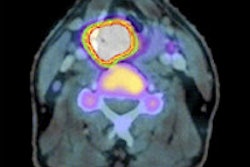
CHICAGO - PET/MRI outperformed diffusion-weighted MRI (DWI-MRI) for detecting lymph node metastases in the staging of head and neck cancer patients, according to a German study presented on Sunday at the RSNA annual meeting.
Researchers from the University of Düsseldorf found that PET/MRI achieved accuracy of 93%, compared with 88% for DWI-MRI. PET/MRI also reached sensitivity of 72%, compared with 36% for DWI-MRI.
The results were presented at the meeting by lead study author Dr. Christian Buchbender, from the department of diagnostic and interventional radiology.
Lymph node status has prognostic value in head and neck cancer because patients with metastases need neck dissection and adjuvant treatment. Therefore, Buchbender noted, precise lymph node staging is a necessity.
"Currently available imaging modalities are restricted in their diagnostic performance for lymph node metastases detection," he added. "For example, CT and MRI fall short in sensitivity when compared to FDG-PET or FDG-PET/CT. On the other hand, FDG-PET/CT suffers from a large amount of false-positive results."
Thus, new modalities or a combination of modalities are needed to improve lymph node metastases detection in these cancer patients, he said.
The prospective study included 14 head and neck cancer patients with a mean age of 67 years. Prior to surgery, the patients received both FDG-PET/CT and 3-tesla MRI, including diffusion-weighted imaging. The patients then underwent bilateral neck dissection.
Using image fusion software, the researchers created two sets of images. One set consisted of PET/MR images, which were created by fusing FDG-PET results with contrast-enhanced, T1-weighted, fat-saturated MR images. The second set consisted of DWI-MR images, created by fusing DWI results with T1-weighted, fat-saturated MR images. Buchbender and colleagues then analyzed both sets of images for the presence of lymph node metastases.
PET/MRI detected 26 (93%) of 28 lymph node metastases, compared with 20 (71%) detected by DWI-MRI, according to the researchers.
The group found comparable specificity between the two modalities, while PET/MRI fared better than DWI-MRI in positive predictive value (PPV) and negative predictive value (NPV). DWI-MRI also proved significantly less accurate than PET/MRI for lymph node cancer detection.
PET/MRI vs. DWI-MRI for lymph node metastases
|
"When we compared these results to available data on PET/CT, we found that PET/MRI pretty much equals the performance of PET/CT," Buchbender added.
One study limitation was that the researchers did not evaluate combined PET/MRI and DWI-MRI for detecting lymph node metastases.
"This is the major advantage of hybrid MRI scanners, which are recently available with the simultaneous acquisition of functional MRI data and PET," Buchbender said. "This certainly has to be addressed in future studies to see if this combination can increase the accuracy of lymph node cancer detection."



















